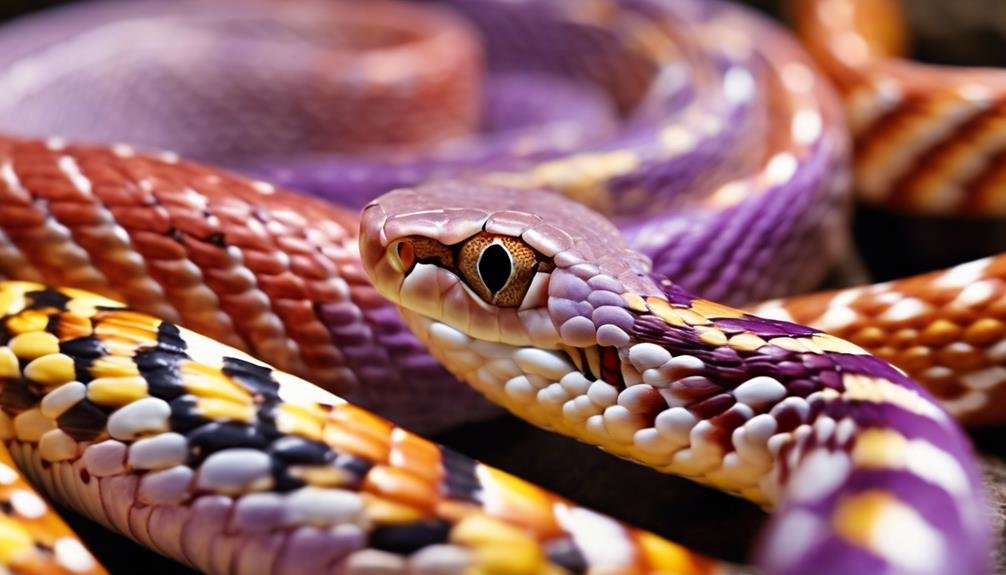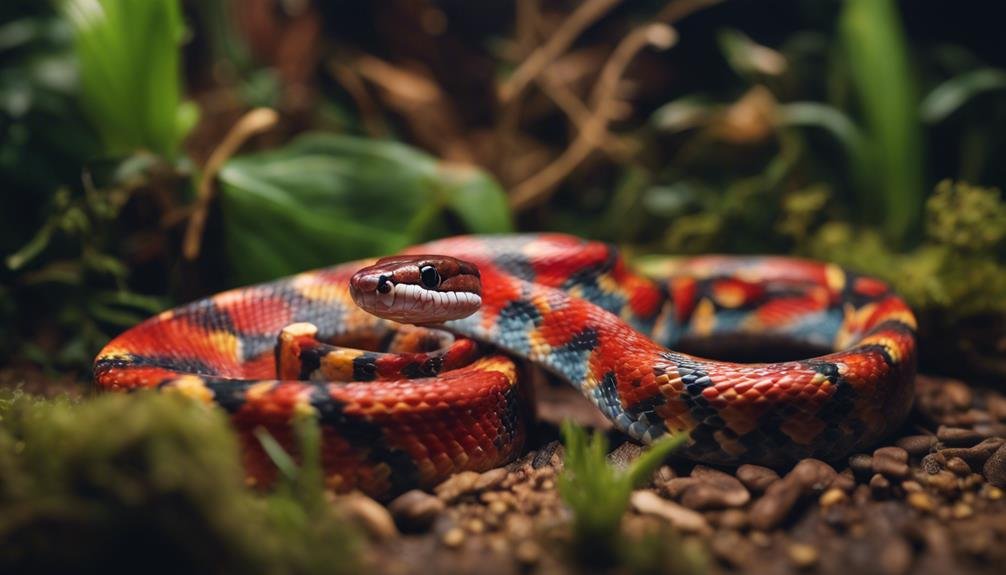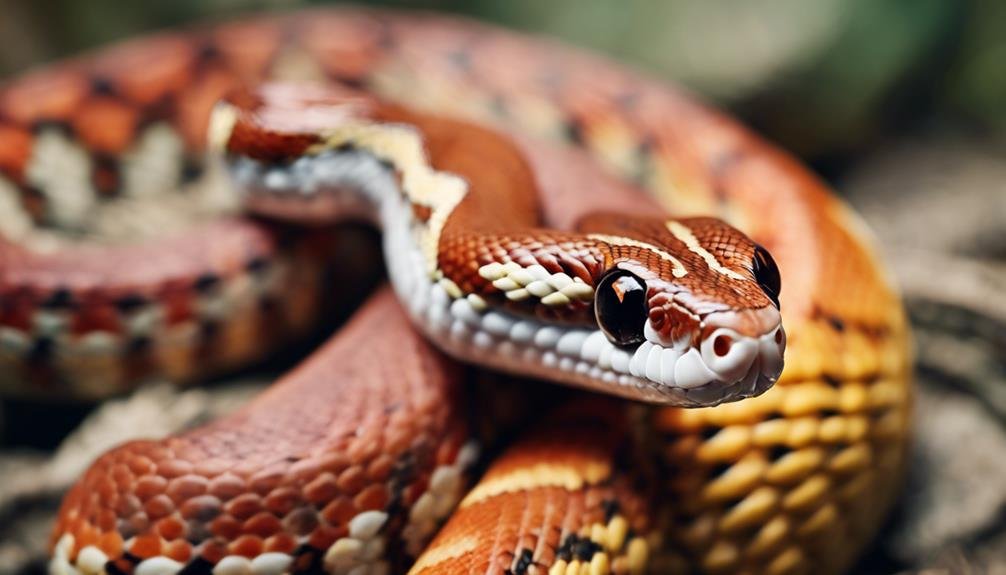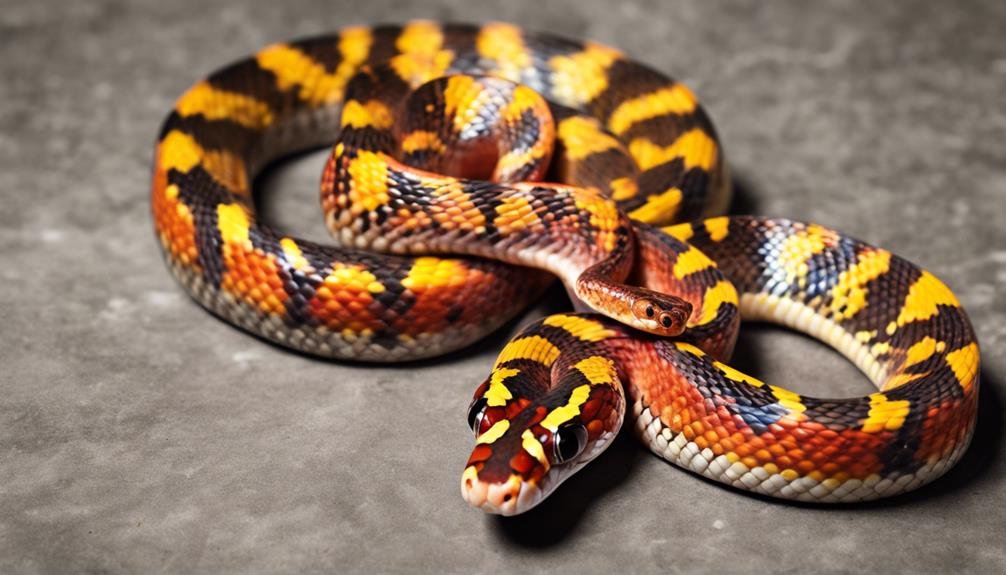If you’ve ever marveled at the vast array of colors and patterns adorning corn snakes, you’re not alone. These morphs, born from both natural variation and selective breeding, offer a palette of visual diversity that’s as fascinating as it is beautiful. But beyond their striking appearances, there’s a complex interplay of genetics at work, influencing not just their looks but their health too. As you explore the world of corn snake morphs, you’ll uncover how specific traits are passed down and what it means for their care and well-being. Let’s peel back the layers to understand the science and art behind these captivating creatures, and perhaps, you’ll find yourself considering more than just their aesthetic appeal.
Key Takeaways
- Corn snake morphs feature a wide range of colors including red, orange, brown, black, white, yellow, and gray, developed through selective breeding.
- Patterns such as saddles, stripes, blotches, and speckles are prominent in corn snakes, contributing to their unique appearances.
- Health considerations for corn snakes include maintaining proper nutrition, habitat temperature (75-85°F during the day), and humidity levels (35-60%).
- Common health issues in corn snakes are mites, respiratory infections, shedding problems, and egg binding, requiring early detection and proper care.
- Popular morphs like Albino, Anerythristic, Palmetto, Tessera, and Charcoal showcase the diversity and beauty of corn snakes through genetic mutations and breeding.
Understanding Corn Snake Morphs
Delving into the world of corn snake morphs reveals the stunning variety and complexity resulting from genetic mutations and selective breeding. You’ll find that these morphs aren’t just random; they’re the culmination of years of dedicated effort by breeders aiming to highlight or enhance specific traits within the species. It’s fascinating how a simple change in genetics can lead to a vast array of appearances in these creatures.
Selective breeding plays a pivotal role in developing new and unique morphs. Breeders select corn snakes with desirable traits and breed them together, hoping to produce offspring that inherit those traits. This process isn’t overnight; it requires patience, knowledge, and a bit of luck. Genetic mutations, on the other hand, are spontaneous changes in the snake’s DNA. These can occur naturally or be induced by breeders looking to create something truly unique.
Understanding corn snake morphs is about appreciating the science and art behind creating these beautiful variations. It’s a demonstration of how genetic mutations and selective breeding can come together to produce an incredible diversity within a single species. Whether you’re an enthusiast or a casual observer, the world of corn snake morphs is both intriguing and educational.
Color Variations and Patterns
Exploring the world of corn snake morphs further, let’s focus on the myriad of color variations and patterns that make each snake truly unique. You’ll find these slithery friends showcasing an impressive palette, including shades of red, orange, brown, black, white, yellow, and gray. It’s not just the colors that catch the eye; the patterns on these snakes are equally enchanting. You might spot corn snakes with saddles, stripes, blotches, speckles, and even checkered bellies. Each pattern contributes to a snake’s distinct appearance, making every individual truly one-of-a-kind.
The incredible variety of corn snake morphs you see today is largely thanks to selective breeding. Breeders have meticulously paired snakes over generations to enhance or combine specific traits, leading to remarkable morphs like albino, anerythristic, caramel, and charcoal. Some morphs, such as Aztec, Palmetto, Tessera, and Calico, are especially sought after for their striking patterns and colors.
Understanding these color variations and patterns in corn snake morphs can deepen your appreciation for the diversity and beauty found within this species. Each morph has its own set of characteristics, contributing to the rich tapestry that makes the corn snake community so vibrant and fascinating.
Popular Morphs Explored


Let’s explore some of the most popular corn snake morphs, showcasing their unique features and what sets them apart in the world of reptile enthusiasts.
Albino corn snakes are a marvel, lacking melanin, which gifts them with mesmerizing shades of red, orange, white, and yellow. Their vibrant appearance draws attention, making them a favorite among collectors.
Then, you’ve got the anerythristic corn snakes, which are the polar opposite when it comes to color. These snakes lack the red pigment, resulting in a stunning array of white, gray, brown, and black. They offer a more subdued beauty, appealing to those who favor a less vivid palette.
Palmetto corn snakes are intriguing with their incomplete dominant trait. Heterozygous snakes resemble hypo corn snakes, while the homozygous ones are mostly white, sprinkled with spots of color, creating a starry night effect on their skin.
Tessera corn snakes boast a dominant mutation, presenting a thin, dark-edged dorsal stripe that can be combined with various color mutations for a truly striking pattern.
Lastly, charcoal corn snakes, also known as Pine Island Black Albino, present a unique contrast. Used in creating morphs like Blizzard and Diamond, they add depth and variety to the corn snake family with their distinct appearance.
Health and Wellness Tips
After exploring the diverse world of corn snake morphs, it’s crucial to focus on keeping your snake healthy and thriving.
You’ll need to understand the essentials of diet and nutrition, recognize the signs of common illnesses, and guarantee your snake’s habitat is set up correctly.
These steps are essential in preventing health issues and ensuring your corn snake lives a long, happy life.
Diet and Nutrition Essentials
To ensure your corn snake thrives, a diet centered around rats and mice is essential for its nutritional needs. Careful attention to feeding schedules and portion sizes is important to avoid overfeeding or underfeeding. It’s not just about what they eat, but how you feed them that matters. Supplementation plays a significant role in maintaining a balanced diet, ensuring your snake gets all the necessary vitamins and minerals for excellent health.
Offering prey that matches your snake’s size and age is crucial for their digestion and overall health. A varied diet not only prevents nutritional deficiencies but also promotes a healthier, more vibrant corn snake. Remember, a well-thought-out nutrition plan is the cornerstone of your pet’s wellbeing, combining diet, nutrition, feeding schedules, and supplementation for the best care possible.
Signs of Common Illnesses
Recognizing the signs of common illnesses in corn snakes is essential for their well-being and longevity. If you spot mites, witness respiratory infections, notice shedding issues, or suspect egg binding in females, it’s time to act.
Unusual behaviors, such as lethargy, loss of appetite, abnormal breathing, or skin discoloration, are red flags indicating potential health problems. Regularly monitoring your corn snake’s weight, skin condition, and eating habits will help you catch these issues early.
Should your corn snake display any of these signs, seeking veterinary care is vital for a prompt diagnosis and treatment. Remember, maintaining a clean environment and offering a balanced diet are key in preventing many health issues, ensuring your corn snake stays healthy and happy.
Habitat Setup Tips
Establishing a comfortable and secure habitat is essential for your corn snake’s health and happiness. Start with a secure enclosure that has a locking mechanism to prevent escapes. For substrate, opt for aspen shavings or coconut husk, which allow for natural burrowing behavior.
Ensure the enclosure includes hiding spots and branches for climbing, which help reduce stress and promote natural behaviors. It’s vital to maintain proper temperature and humidity levels for your snake’s well-being.
Regularly cleaning and sanitizing the habitat prevents harmful bacteria and parasites from building up.
| Requirement | Details | Reason |
|---|---|---|
| Substrate | Aspen shavings/Coconut husk | Mimics natural habitat, allows burrowing |
| Temperature & Humidity | Proper levels must be maintained | Supports health and well-being |
| Hiding Spots & Climbing | Include hiding spots and branches | Reduces stress, promotes natural activities |
Diet and Nutrition Essentials
Ensuring your corn snake receives a balanced diet is essential for its health and longevity. In captivity, the cornerstone of their diet is rats and mice, which mirror the variety they’d hunt in the wild, including small mammals, birds, and eggs. This variety isn’t just about keeping mealtime interesting; it’s about providing the full spectrum of nutrition your slithery friend needs to thrive.
A proper feeding schedule is vital. It’s not just about what you feed but also when and how much. Overfeeding can lead to obesity, while underfeeding can cause malnutrition. Both scenarios can severely impact your corn snake’s health. Feeding schedules and portion sizes should be tailored to your snake’s age, size, and activity level, with adjustments made as necessary.
Habitat Requirements


Moving on from diet and nutrition, you’ll also need to understand the habitat requirements for your corn snake. Ensuring the ideal temperature range, correct humidity levels, and the right substrate and shelter are critical for their well-being.
You’ll find that setting up a comfortable and secure environment for your corn snake isn’t just important; it’s essential for their health and happiness.
Ideal Temperature Range
To maintain your corn snake’s health, you’ll need to keep the habitat’s temperature between 75-85°F during the day, allowing for a cooler drop at night. This temperature range is important for mimicking their natural environment and ensuring their well-being.
A nighttime temperature drop of 10-15°F isn’t just recommended, it’s essential for replicating the natural cooling that occurs after sunset, promoting healthy physiological processes.
Additionally, observing a winter cool-down period, or brumation, is essential if you’re considering breeding. This mimics the colder conditions they’d experience in the wild during winter, preparing their bodies for the breeding season.
Humidity Levels
Just as the right temperature range is key for your corn snake’s environment, maintaining proper humidity levels is equally important for their health. Your corn snake requires a humidity level of 35-60% to stay healthy. This range aids in shedding and prevents dehydration.
You must monitor humidity levels with a hygrometer to make sure they remain within this recommended range. Remember, too high humidity can lead to respiratory issues, while too low can cause difficulty in shedding.
To help your corn snake regulate its moisture levels effectively, provide a humidity box filled with damp moss. This simple addition can make a significant difference in maintaining the right humidity levels for your corn snake’s wellbeing.
Substrate and Shelter
Selecting the right substrate and providing adequate shelter are essential to creating a comfortable habitat for your corn snake. For substrate, opt for loose materials like aspen shavings or coconut husk, which allow your snake to burrow and exhibit natural behaviors. If ease of cleaning is a priority, inkless newspaper is a practical choice. However, steer clear of pine or cedar shavings, as these can harm your corn snake’s respiratory system.
Don’t forget to include hide boxes and hiding spots within the enclosure to help your snake feel secure and minimize stress. Additionally, adding a forked branch can offer your corn snake valuable climbing exercise, enhancing its overall well-being and environment.
Common Health Issues


Several common health issues can affect corn snakes, including mites, parasites, respiratory infections, shedding complications, and egg binding in females. You need to be vigilant in spotting these problems early on. Regular health checks become essential, allowing you to catch and address issues before they worsen.
Mites and parasites can be particularly troubling, often indicating that the living conditions mightn’t be ideal. Maintaining ideal temperature, humidity, and cleanliness within your corn snake’s habitat is your first line of defense against these pests. If you notice your snake showing signs of respiratory infections, like wheezing or mucus around the nostrils, it’s a clear signal that the humidity or temperature may not be properly regulated. Similarly, shedding complications often arise from inadequate humidity levels, making it difficult for your snake to shed its skin in one complete piece.
Don’t hesitate to seek veterinary care if you observe any persistent or worsening symptoms. Sometimes, despite your best efforts, professional intervention is necessary to safeguard your corn snake’s health. Educating yourself about these common health issues and their prevention is key to providing a safe, comfortable environment for your pet.
Do Different Corn Snake Morphs Have Different Nocturnal Habits?
Yes, corn snakes are crepuscular, meaning they are most active during dawn and dusk. Different morphs of corn snakes do not have different nocturnal habits. However, individual snakes may display variations in behavior based on factors such as age, health, and environmental conditions.
Selecting Your Corn Snake
When you’re selecting your corn snake, it’s important to explore the various color morphs available to discover one that truly captivates you. The selection includes vibrant options like Okeetee, Miami, Keys, Albino, and Anerythristic. Each morph showcases unique characteristics, from distinct saddle markings and base color to pattern variations. This diversity allows you to choose a corn snake that resonates with your personal aesthetic.
Moreover, it’s vital to explore the rarity and pricing of certain morphs. For instance, Palmetto, Tessera, Calico, Caramel, and Cinder morphs might come with a higher price tag due to their scarcity. Learning about the genetic traits and how they’re inherited in corn snakes will deepen your understanding of what makes each morph special.
Don’t overlook the unique features of morphs like Aztec, Diffused, Dilute, and Charcoal. Each brings something different to the table, from subtle pattern differences to striking color contrasts. By understanding these details, you’ll make an informed decision, ensuring your new pet not only meets your desires in terms of appearance but also fits your budget and care capabilities.
Conclusion
To sum up, delving into the world of corn snake morphs unveils a domain of vibrant colors and unique patterns that make each snake truly special. By exploring popular morphs, you’ve gained insight into the remarkable diversity within this species.
Remember, ensuring the health of your corn snake involves more than just appreciating their beauty; it’s about providing the right diet, habitat, and care to prevent common health issues. Therefore, when choosing your corn snake, prioritize their well-being to savor a long, shared journey together.


